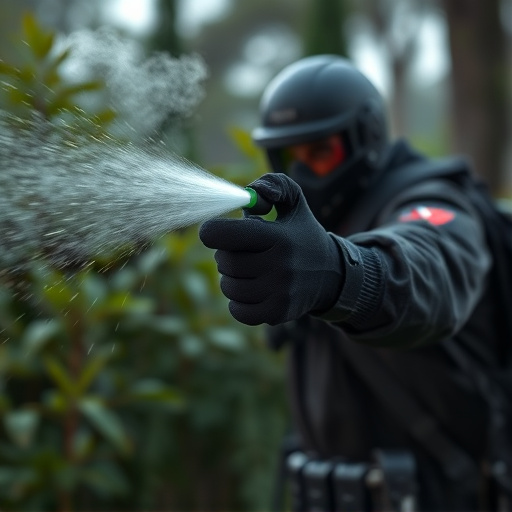“Discover the power of capsaicin, the fiery compound behind pepper spray, as an inflammatory agent deterrent. This article explores how understanding capsaicin’s properties can empower you to take control of your safety. Learn practical steps for decontaminating your space with pepper spray at home through a comprehensive guide. From preparation to post-exposure care, we’ll cover all the essential precautions and safety measures. Arm yourself with knowledge on effective pepper spray decontamination steps, ensuring your peace of mind in today’s world.”
- Understanding Capsaicin and Its Inflammatory Properties
- Pepper Spray Decontamination: A Step-by-Step Guide for Home Use
- Precautions and Safety Measures When Handling Pepper Spray
Understanding Capsaicin and Its Inflammatory Properties
Capsaicin, the active ingredient in pepper spray, is a natural compound derived from chili peppers. Its primary function is to deter and incapacitate attackers by inducing pain and irritation through its inflammatory properties. When sprayed onto skin or eyes, capsaicin binds to specific nerve endings, triggering a burning sensation and causing temporary blindness.
Understanding the decontamination steps after exposure to capsaicin pepper spray at home is crucial. Immediate washing with plenty of water for at least 15 minutes can help flush out the compound. Using mild soap and warm water further assists in removing any residual traces. For eye exposure, rinsing the eyes with clean water for several minutes is recommended while seeking medical attention if irritation persists.
Pepper Spray Decontamination: A Step-by-Step Guide for Home Use
Pepper spray, while effective as a deterrent, can leave behind an unpleasant residue and strong odor that require proper decontamination. Here’s a step-by-step guide for safe and effective pepper spray decontamination at home:
1. Ventilate the Area: Open windows and doors to ensure the space is well-ventilated. Pepper spray particles can linger in enclosed areas, so proper air circulation helps dissipate the scent and reduce exposure to capsaicin. Use fans or turn on exhaust vents if available to enhance airflow.
2. Remove Contaminated Clothing: Take off any clothing or accessories that came into direct contact with the pepper spray. Don’t wash these items yet; instead, place them in a sealed plastic bag for later disposal. Put on clean, fresh clothes to prevent further contamination and cross-contamination.
3. Wipe Down Surfaces: Use warm, soapy water and a soft cloth or sponge to wipe down all surfaces that came into contact with the spray, including floors, countertops, furniture, and appliances. Rinse the cloth frequently in hot, soapy water to avoid spreading the residue around.
4. Rinse Affected Areas: For hard surfaces like tile, concrete, or stainless steel, use a solution of one part white vinegar and two parts warm water. Apply the solution with a clean sponge or cloth, then wipe away any visible residue. This natural cleaner helps neutralize pepper spray components while leaving no harsh residues behind.
5. Disinfect High-Touch Surfaces: After wiping down all contaminated areas, use a disinfectant spray or wipes to target high-touch surfaces like doorknobs, light switches, and remote controls. Follow the manufacturer’s instructions for proper application and contact time to ensure effective disinfection.
6. Laundry Time: Wash any bedding, curtains, or other washable items that may have been exposed to pepper spray in hot water (at least 130°F/54°C) using a strong detergent. This will help remove residual capsaicin and prevent it from adhering to fabrics. Avoid using fabric softeners until the affected area is completely clean.
Precautions and Safety Measures When Handling Pepper Spray
When handling capsaicin inflammatory agent deterrent spray, known commonly as pepper spray, safety should be a top priority. Always wear protective gear, including gloves and eye protection, to minimize direct contact with the skin and eyes. In case of accidental exposure, follow immediate decontamination steps at home. Start by removing any contaminated clothing and washing affected areas with soap and warm water for at least 15 minutes. Pepper spray can be removed from surfaces using a solution of one part mild detergent and three parts water.
It’s crucial to ensure proper ventilation during and after use. Avoid breathing in the spray mist and keep the area well-ventilated. In case of inhalation, move the affected person to fresh air immediately. Seek medical attention if irritation or difficulty breathing persists. Store pepper spray out of reach of children and pets, and always follow local regulations regarding its use and possession.
Capsaicin, the active ingredient in pepper spray, offers a powerful deterrent against inflammatory agents. By understanding its properties and implementing proper decontamination steps at home, as outlined in this guide, individuals can effectively protect themselves and their spaces. Remember to always prioritize safety when handling any type of spray, and be prepared with knowledge and the right tools to navigate potential threats.
